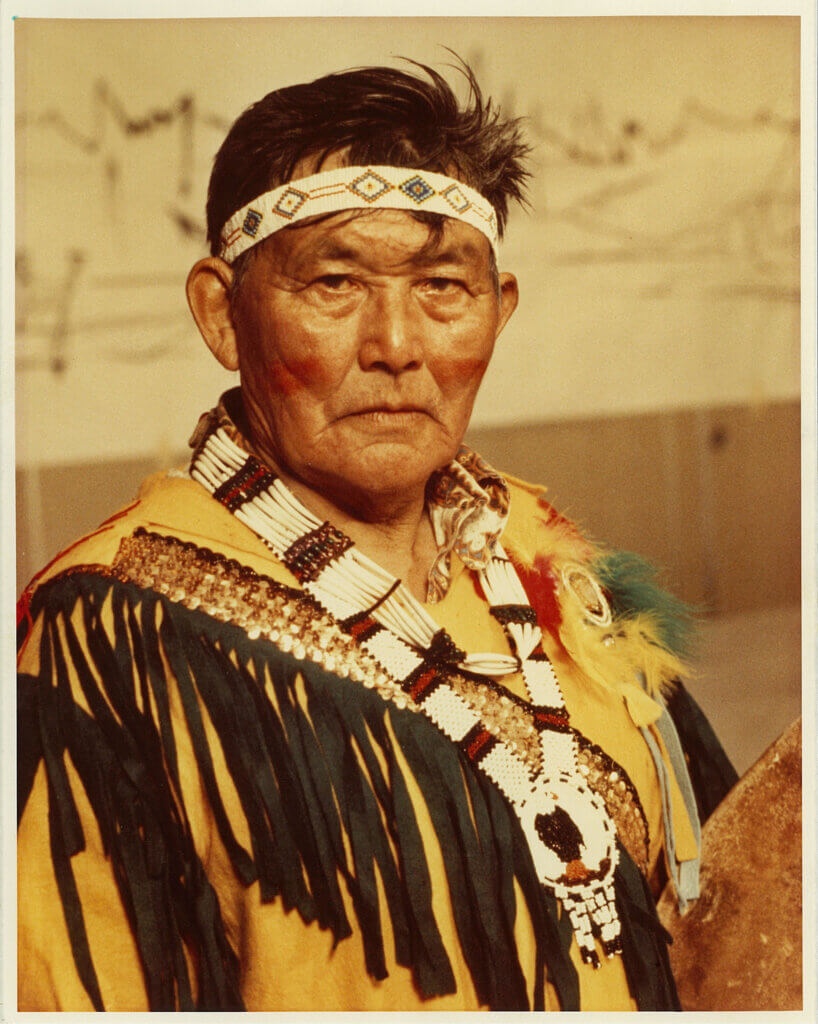
Born April 16, 1898 in between Joseph Village and Kechumstuk in a camp shelter, Chief Andrew Isaac was given the name Aandoo’ by Chief Harry Luke, a relative of his grandfather Chief Isaac. Being educated by many great Chiefs since he was a boy, Chief Andrew Isaac learned all aspects of the Athabascan lifestyle.
The year 1904 marked the first time Chief Andrew Isaac met a western person. Episcopal Archdeacon Hudson Stuck came through speaking a foreign language, English. One day as a child Chief Andrew Isaac was on a hunting trip and was accidentally shot by his friend. He remembered the prayers he had learned at church and prayed several times on his way back to the village. He lost so much blood that he had grown weak and was near death. The young Chief Andrew Isaac made a miraculous recovery in just four days and ever since then was a believer and follower of God.
It was about that time when the Athabascan people encountered their first epidemic, the German Measles. This was not the only epidemic that killed many Athabascans. In 1924, Lake Mansfield caught their first spell of the flu. Nearly two dozen people passed away in one week. Chief Andrew Isaac was one of the first to catch the flu and was fortunate enough to survive. After the flu had passed, the Chief recalls having held potlatches for three years to commemorate the deceased.
At the age of 11, Chief Andrew Isaac became employed in the coal mines and then later in the gold mines. Gold prospectors used to pay five dollars per day to incorporate Athabascan laborers as supply carriers for exploration. Chief Andrew Isaac recalled spending weeks at a time guiding prospectors through the wilderness.
In 1932 Chief Andrew Isaac was appointed Chief of the United Crow Band by his uncle Walter Isaac. His Uncle told him that it was his duty as an Athabascan Indian to choose the next leader before he passed on. Since Chief Andrew Isaac was known to live an honest, healthy and respectful life, he was chosen as the next leader.
Chief Andrew Isaac played a large role in the settlement over Alaska Native land claims. In 1966 in Anchorage , he argued for the land rights of Native people; undoubtedly, this helped to sway the Secretary of Interior Stewart Udall to issue a “freeze” on all future land transfers. With the land freeze, Alaska Native peoples’ rights to the land were ensured; transfers would not occur without an agreement from the Alaska Native people. He believed the Athabascan people should never sell their land.
In 1972, he was appointed the first Traditional Chief of the Athabascan people by Tanana Chiefs Conference. Then in 1979, he was awarded an honorary doctorate of the humanities by the University of Alaska Fairbanks. One of the many honors awarded Chief Andrew Isaac included the Indian Health Service clinic, located in Fairbanks, named after him.
Chief Andrew Isaac, his wife Maggie Isaac, and their four children moved to Dot Lake in 1946 where he remained until a year before his death on March 23, 1991 at the age of 93.
With all of the events that happened throughout his life, Chief Andrew Isaac believed they all happened for a reason and that everyone is alive for a purpose. He had strong beliefs toward alcohol and drugs and their negative effect on the youth. He often spoke of this effect along with his encouragement for following the traditional Athabascan ways of listening to the elders, working hard and respecting the land and its resources. As the first Traditional Chief, he helped to successfully guide his people into modern times using his strong belief in Athabascan values and his knowledge from the ancestors.
